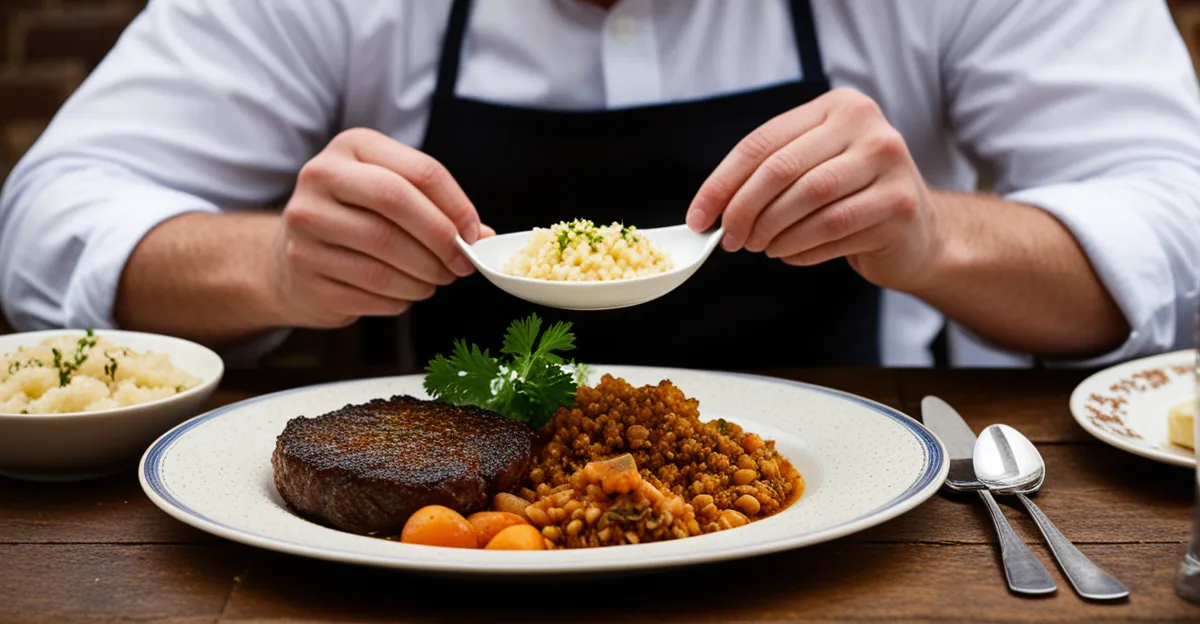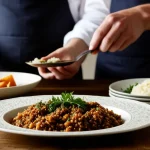Defining the Characteristic Flavors of Traditional UK Cuisine
Traditional UK dishes are deeply rooted in a rich history of cultural exchange and resourcefulness. The characteristic flavors of UK food have evolved through centuries of agricultural practices, trade, and regional adaptation. This historical backdrop sets the stage for understanding the unique British flavors that define the nation’s culinary identity.
Common ingredients such as root vegetables, lamb, beef, and hardy grains form the backbone of many traditional UK dishes. These ingredients are prepared using cooking techniques like slow roasting, simmering, and stewing, which enhance the development of complex and comforting flavors. For example, the slow cooking of meats in dishes like stews intensifies their savory qualities while blending with earthy vegetables, creating balanced and hearty meals.
Also to see : What are the steps to making a perfect roast dinner?
Core seasonings including thyme, rosemary, sage, and black pepper play a pivotal role in shaping the unique British flavors. Unlike cuisines that rely heavily on strong spices, traditional UK cuisine favors these aromatic herbs, which add subtle, herbaceous undercurrents to dishes without overpowering the natural taste of ingredients. The use of salt and vinegar is also notable; these simple seasonings enhance the freshness and preserve the natural flavors, characteristic of classic UK food.
Understanding these foundational elements—historical influences, staple ingredients, cooking methods, and key seasonings—provides a comprehensive picture of the attributes that give traditional UK dishes their distinctive, familiar taste.
Also to discover : How Can Traditional British Recipes Be Adapted for Modern Dietary Trends?
Signature UK Dishes and Their Distinctive Tastes
Delving into traditional UK dish flavors reveals a rich tapestry of savory, hearty, and layered tastes that reflect the country’s culinary heritage. Take, for example, roast beef—a cornerstone of British food examples. This dish is celebrated for its savoury depth, achieved through slow roasting, which intensifies the natural flavors of the meat. The addition of aromatic herbs like rosemary and thyme complements the beef, adding subtle herbaceous notes that enhance the overall profile without overwhelming it.
Another iconic dish, shepherd’s pie, embodies the comforting essence of UK food characteristics. Its rich, meaty filling—customarily made with minced lamb—is harmoniously balanced by a creamy mashed potato topping. This combination highlights how texture and flavor interplay in traditional UK dishes, creating a satisfying experience that emphasizes both robustness and softness.
Black pudding stands apart with its distinctive, robust taste. This traditional UK dish incorporates unique ingredients such as blood and oatmeal, which bring forward spicy and earthy nuances. These complex flavors are a result of the careful blending and seasoning, making black pudding a flavorful example of how UK cuisine embraces bold, authentic profiles while honoring long-standing preparation methods.
Together, these dishes illustrate the unique British flavors that have been perfected through generations, showcasing how thoughtful ingredient selection and time-honored cooking techniques foster celebrated flavors in UK food.
Regional Flavor Profiles Across the United Kingdom
Regional UK cuisines present a fascinating spectrum of local British flavors, each shaped by distinct landscapes, climates, and cultural heritages. The UK culinary diversity becomes evident when contrasting the food traditions of England, Scotland, Wales, and Northern Ireland, where ingredients and seasonings reflect the geography and history of each nation.
In England, traditional UK dishes often incorporate root vegetables, beef, and herbs like thyme and rosemary, emphasizing a savory and hearty palate. Scottish cuisine, meanwhile, features ingredients like salmon, game meats, and oats, lending dishes a heartier, sometimes smoky character. The use of heather and seaweed as seasonings illustrates a unique embrace of local flora and coastal resources. Wales is known for its lamb, leeks, and cheese, with dishes reflecting the agricultural bounty of its hills and valleys. The delicate use of seasonal herbs highlights the subtlety in Welsh flavors, emphasizing freshness. Northern Ireland adds its own twist with dishes that use potatoes and soda bread prominently, alongside distinctive use of root vegetables and freshly caught seafood.
Examples of uniquely flavored specialties illuminate this variety. Scottish haggis combines minced offal with oats and spices, producing a deeply savory and aromatic flavor profile. Welsh cawl, a slow-cooked stew with staple vegetables and lamb, offers a comforting balance reflective of local produce. Irish champ, mashed potatoes with scallions, lends a simple yet distinct taste borne from the region’s ingredients.
Overall, the regional UK cuisines each contribute to a rich mosaic of tastes that encapsulate the diversity of British culinary tradition. These local British flavors not only honor historic practices but also highlight how geography and resourcefulness fuel enduring and distinctive UK food characteristics.
Cultural Traditions and Their Influence on UK Culinary Flavors
The UK food culture is deeply intertwined with the nation’s rich history, where centuries of tradition continue to shape the evolution of traditional UK dishes. The persistence of classic British culinary tradition is evident in recipes passed down through generations, maintaining core UK food characteristics while adapting to changing tastes and ingredient availability. This evolving yet stable nature ensures that heritage flavors remain central to the British palate.
Food rituals and celebrations play a vital role in reinforcing specific flavor preferences. For example, Sunday roasts and seasonal festivals highlight dishes that emphasize hearty, savory profiles using ingredients like lamb, beef, and root vegetables. These occasions elevate the cultural importance of traditional UK dishes, anchoring them in collective memory and everyday life. Such rituals support the enduring popularity of unique British flavors that symbolize comfort and community.
Local produce and historic accessibility have profoundly influenced the UK dish history. The reliance on indigenous ingredients—such as oats in Scotland or leeks in Wales—not only reflects geographic realities but also reinforces signature tastes of each region. This commitment to local sourcing preserves authentic flavors within UK culinary tradition, underscoring the connection between environment and cuisine. Ultimately, the interplay of cultural practices, seasonal celebrations, and regional agriculture defines the rich taste landscape of traditional UK food.










